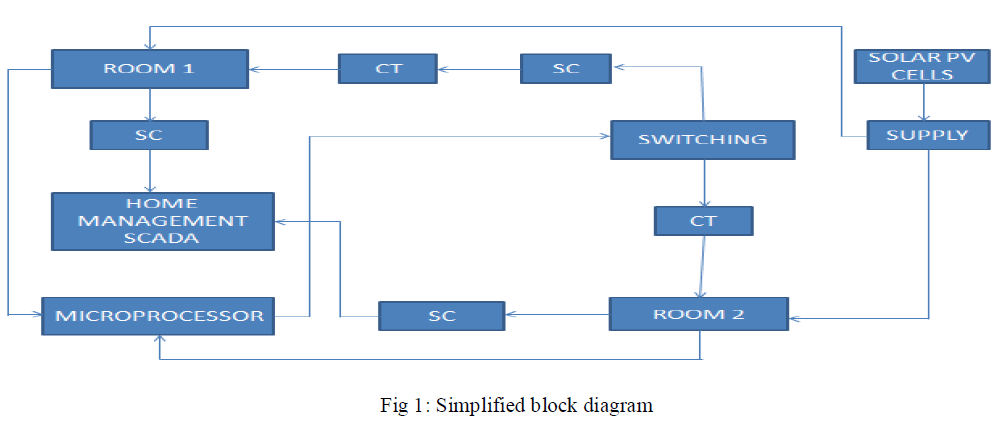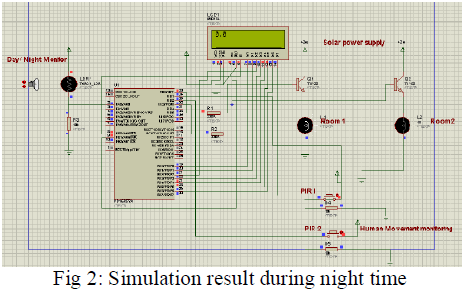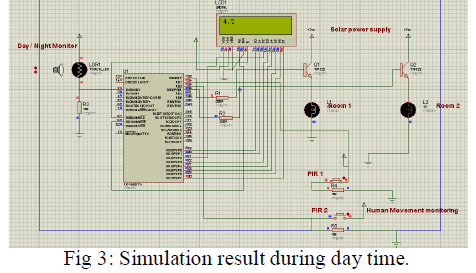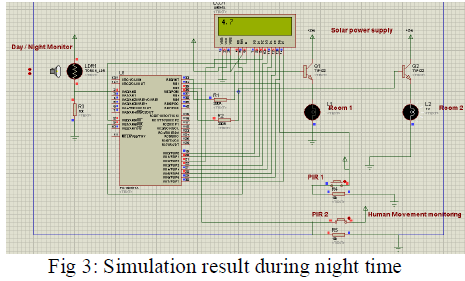ISSN ONLINE(2278-8875) PRINT (2320-3765)
ISSN ONLINE(2278-8875) PRINT (2320-3765)
Vishal Nair1, S Aravindhan2, V G Padhmanabhan3,Mrs S Bharati4, Dr. K Sathiyasekar5
|
| Related article at Pubmed, Scholar Google |
Visit for more related articles at International Journal of Advanced Research in Electrical, Electronics and Instrumentation Engineering
Around 25,00 villages are located in remote and inaccessible areas of Tamil Nadu and hence could not be electrified through conventional grid extension in India. The Ministry of New and Renewable Energy (MNRE) is implementing the ‘Remote Village Electrification Programme’ (RVEP) to electrify such remote villages by installing solar photovoltaic (PV) home lighting systems. The functionality of the system varies across the states and across the seasons. During rainy season on an average one luminaire works 2 to 3 hours. During winter and summer on an average one luminaire works 4 to 5 hours. However, performance declines over the years. Use of kerosene is reducing in rural areas. Nearly 53 to 69 per cent reported that there is significant improvement in their children’s education, and 37 to 78 per cent reported that there is improvement in the standard of living after the installation of solar lighting. All though just implementing solar grid won't be handful. We also need to implement a SCADA system for controlling and monitoring the solar energy. We have proposed a system using home SCADA technology with priority switching.
Keywords |
| Home management SCADA, Renewable energy, Motion Sensors, Priority Switching. |
INTRODUCTION |
| Rural electrification was not considered as a basic human need like water and food in the past. A number of recent studies provide insight into how rural electrification helps in the betterment of rural society in various ways. A study the World Bank for 11 countries reveals that rural electrification results great benefits such as improvements of health facilities, better health from cleaner air as household reduce use of polluting fuels for cooking, lighting and heating, improved knowledge through increase access to television and better nutrition from improved knowledge and storage facilities from refrigerator. Children in rural areas spend significant portion of their time in household’s activities in day time. They do not have light to study at night. A few hours of electricity to study at night students can result in major improvements in their performance. Women in rural areas spend 2-6 hours a day for collecting fire wood due to lack of electricity. |
| Therfore, rural electrification may be considered as basic necessity to improve socio-economic condition in rural areas |
| There is no doubt that energy is needed to achieve an acceptable quality of life for the global village as a whole. Over the next few decades, a wide range of energy forms will be required to satisfy the increasing global demand. Moreover, our global energy system is such that the developed and developing countries are interdependent in their efforts to provide sufficient and affordable energy, and to maintain an ecologically sound planet. This has a great significance for developing countries like India where the major economic activity is agriculture and supply of reliable power particularly to rural areas is of importance in accelerating growth. It is also needed to promote other economic activities for growth and development |
| This paper presents a monitoring and control method of any integrated system, which is crucial for efficient operation of the plant. The proposed SCADA based operation of integrated system leads to relieving human operator from routine processes by interfacing to computer, thus resulting in man machine interfaced system. Results reveal that such an interfaced system takes care of matching demand and supply to fulfill the needs of power, monitor and record various parameters of sources such as current and power supplied, demand met and recording of events at regular intervals. |
SYSTEM UNDER STUDY |
 |
A. Solar PV Cells |
| Photovoltaics (PV) is a method of generating electrical power by converting solar radiation into direct current electricity using semiconductors that exhibit the photovoltaic effect. Photovoltaic power generation employs solar panels composed of a number of solar cells containing a photovoltaic material. Materials presently used for photovoltaics include monocrystalline silicon, polycrystalline silicon, amorphous silicon, cadmium telluride, and copper indium gallium selenide/sulfide. Due to the increased demand for renewable energy sources, the manufacturing of solar cells and photovoltaic arrays has advanced considerably in recent years. |
B. Supply/Battery |
| The solar energy coming from the sun has to be stored in a battery. We cannot use the heat energy directly coming from the sun. We need to convert it from one form to another i.e from heat energy to electrical energy . This conversion will be done by the solar panel and the energy needs to be stored in a battery. The battery then has to supply to the loads. Here we use AGM batteries Absorbed Glass Mat batteries are in my opinion the best available for Solar Power use. A woven glass mat is used between the plates to hold the electrolyte. They are leak/spill proof, do not out gas when charging, and have superior performance. They have all the advantages of the sealed gel types and are higher quality, maintain voltage better, self discharge slower, and last longer. The Sun Xtender series by Concorde Battery is an excellent example of AGM batteries.C.Switching/Relay |
C.Switching/Relay |
| A relay is an electrically operated switch. Many relays use an electromagnet to mechanically operate a switch, but other operating principles are also used, such as solid-state relays. Relays are used where it is necessary to control a circuit by a low-power signal (with complete electrical isolation between control and controlled circuits), or where several circuits must be controlled by one signal. The first relays were used in long distance telegraph circuits as amplifiers: they repeated the signal coming in from one circuit and re-transmitted it on another circuit. |
D. Signal Conditioner |
| Signal Conditioning means manipulating an analog signal in such a way that it meets the requirements of the next stage for further processing. Most common use is in analog-to-digital converters. . Operational amplifiers (op-amps) are commonly employed to carry out the amplification of the signal in the signal conditioning stage. Here too we are using op-amp signal conditioner Also it's a very low cost device and can be used easily with less maintenance. |
E. Current Transformer |
| A CT is similar to a electrical power transformer to some extent, but there are some difference in construction and operation principle. For metering and indication purpose, accuracy of ratio, between primary and secondary currents are essential within normal working range. Normally accuracy of current transformer required up to 125% of rated current; as because allowable system current must be below 125% of rated current. Rather it is desirable the CT core to be saturated after this limit since the unnecessary electrical stresses due to system over current can be prevented from the metering instrument connected to the secondary of the CT as secondary current does not go above a desired limit even primary current of the CT rises to a very high value than its ratings. So accuracy within working range is main criteria of a CT used for metering purpose. The degree of accuracy of a Metering CT is expressed by CT Accuracy Class |
F. 8 bit controller |
| Here we are using PIC 16f877a controller for controlling operation. It's fast response and very high speed with great accuracy makes it the most advantageous of all the controllers we use. it also requires lesser space and easy for maintenance. This controller only will recieve the signal from the PIR sensor which is used for motion sensing and it will hence give instruction to the relay to give the supply to room or not. |
G. Passive infrared detectors |
| A passive infrared sensor (PIR sensor) is an electronic sensor that measures infrared (IR) light radiating from objects in its field of view. They are most often used in PIR-based motion detectors. All objects with a temperature above absolute zero emit heat energy in the form of radiation. Usually this radiation is invisible to the human eye because it radiates at infrared wavelengths, but it can be detected by electronic devices designed for such a purpose.The term passive in this instance refers to the fact that PIR devices do not generate or radiate any energy for detection purposes. They work entirely by detecting the energy given off by other objects.[1] It is important to note that PIR sensors don't detect or measure "heat" per se; instead they detect the Infrared radiation emitted from an object which is different from but often associated/correlated with the object's temperature (e.g., a detector of X-rays or gamma rays would not be considered a heat detector, though high temperatures may cause the emission of X or gamma radiation |
HOME MANAGEMENT SCADA. |
| The term SCADA usually refers to a central system that monitors and controls a complete site. SCADA industry was essentially born, out of a need for a user friendly front-end to control system containing Programmable Logic Controllers (PLC). SCADA gathers information from PLCs via some form of communication formats and combines it. A sophisticated SCADA may also be linked to a database to provide instant trending, diagnostic data, scheduled maintenance procedures, logistic information, detailed schematics for a particular sensor or machine and expert-system troubleshooting guides. Hardware for SCADA is generally ruggedized to withstand temperature, vibration, and voltage extremes, but in these installations reliability is enhanced by having redundant hardware and communications channels. SCADA mainly consists of three components: |
A .The Remote Terminal Units (RTUs) |
| RTUs are special purpose computers which contain analog to digital converters (ADC), digital to analog converters (DAC), digital inputs (status) and outputs (control). RTUs are ruggedly constructed; inputs and outputs are fully protected against spurious electrical transients per surge withstand capability (SWC) test specified by IEEE Std. 472. An RTU may have multiple communications ports so that more than one master station can share the RTU. RTU software is written by the manufacturer, usually in a high level language such as C, and is designed to interpret commands (polling requests) from a master computer and to initiate reports of out of bound conditions. If the RTU has sufficient processing power, local control may be possible. |
B. The master station |
| It monitors and controls RTUs and their attached electric apparatus. Master Station has a core program, which is called operating system. Running on operating system are the application programs written by the utility or SCADA vendor. Master Station not only monitors and controls RTUs but can call up customer records from a networked billing computer. |
C .Communication system- |
| To connect RTUs and master stations, a wide area network (WAN) is required, typically composed of more than one media type because a single technology is often not economically practical for utilities that span several states. For long distances, power line carrier has been used for voice and protective relaying, while telephone lines and microwave relays were the only choices until long distance fiber optic systems became available. Some other communication systems used are Multiple Address Systems (MAS), microwaves, metallic cables, fibre optics etc. |
| Here home management SCADA implies that the same system will be made more compact and a smaller module will be implemented and installed in each home. By doing this we can control each and every house and thereby we can monitor the parameters of each house separately. |
BRIEF EXPLANATION OF BLOCK DIAGRAM |
| Here we have given supply directly to switching device first. From the switching device only the supply must be given to room. Now in the room passive infrared sensors will be kept which will sense the motion and give it to microcontroller. once the motion is being sensed microcontroller will give command for the closing of relay and then supply will be given to the room. The same happens for both the room an if someone leaves the room the sensor again will give the command to microcontroller and this controller will open the relay |
| During the evening time we will be priotising the supply only to one room and only to that room the supply will be given. |
SIMULATION RESULTS |
 |
| Here in this block we have shown the simulation result during night time. As we can see the day night monitor which implicates the solar light. The lcd value which measures the light intensity also shows zero value which indicates its night time. During night time we have employed priority switching and priority has been given to room 1 only. So during this period light glows in room 1 only. |
 |
| Here in day time solar energy will be produced. During day time priority switching will be cancelled and rooms will work in normal mode. We have installed sensors in each room. Once motion is sensed in the room the sensors will sense it and sends it to microcontroller. Microcontroller will then close the relay and supply will be given to room . |
 |
| Here too simulation result will be same as in room 1. If motion is sensed in room 2 same operation will be carried out as in room 1. |
CONCLUSION |
| In this paper we have showed how we can improve the living standards in rural areas. We have proposed a system in which renewable energy can be utilized and monitored also. If this is practiced in real time we can get favorable results and help in development of our nation by developing rural areas. |
References |
|